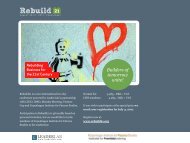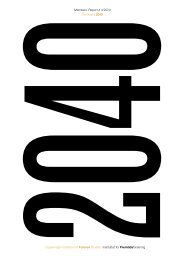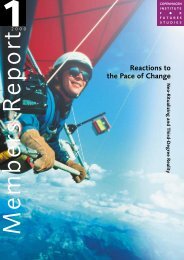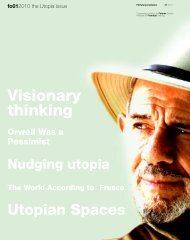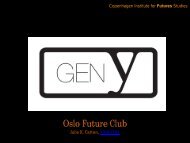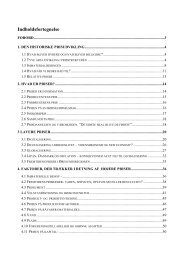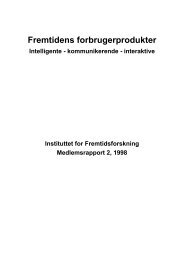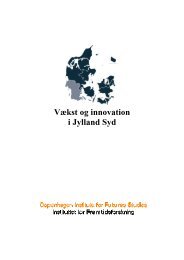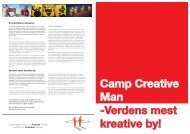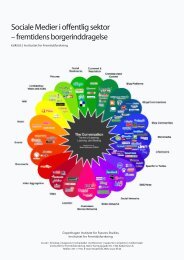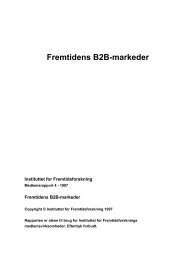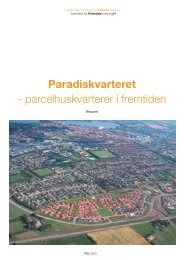Branding.
Branding.
Branding.
You also want an ePaper? Increase the reach of your titles
YUMPU automatically turns print PDFs into web optimized ePapers that Google loves.
8<br />
Two central uncertainties<br />
for branding<br />
<strong>Branding</strong> is of course also going to be a diverse phenomenon ten years from<br />
now. The purpose of this report is thus to outline the range of possibilities<br />
through different images of the future. What trends in branding will be the<br />
dominant in ten years? What new trends will have arrived?<br />
As a start, it is interesting to note that the development in the dominant<br />
corporate branding even today seems to pull in two different directions.<br />
On the one hand it is by now commonly acknowledged that a company<br />
can't be something for everyone. That you have to probe the terrain and formulate<br />
your unique traits and your values. That communication should be<br />
consistent in order to penetrate. And that the goal is to become a strong and<br />
unambiguous corporate brand, which the stakeholders will follow.<br />
With this increased focus on corporate branding we have in a way come<br />
full circle history-wise, since once again it is the company (the grocer), not<br />
the product (the brand as interface), that is in focus. Note that the customer<br />
is somewhat absent in this relation.<br />
On the other hand, the ethical focus, as expressed in the idea of the triple<br />
bottom line, outlines a path towards increased ambiguity. The focus is directed<br />
away from the company towards the surrounding world. If corporate<br />
branding is an attempt to create clarity in a complex world by introducing<br />
an unambiguous culture (values, rules, order, safety), this trend is rather an<br />
attempt to reflect the complexity and hence operate on the terms of the centre-less<br />
world, where it no longer is possible to view and comprehend the<br />
world through a single optic.<br />
The triple bottom line can thus be expanded to a strongly differentiated<br />
communication towards all interested parties in and around the company. In<br />
its ultimate consequence this will lead to an atomisation of the organisation,<br />
held loosely together by a loosely defined structure. I.e., no overarching common<br />
values, but a heterogeneity that in principle can exist all the way down<br />
to the level of the individual person and can reflect the increasing individualisation<br />
in society.<br />
THE CENTRE-LESS WORLD is<br />
described in the book Det hyperkomplekse<br />
samfund (The Hyper-<br />
Complex Society) by Lars<br />
Qvortrup. The idea is that the<br />
world no longer has a single central<br />
point; it no longer has a centre.<br />
Earlier societies had as their<br />
centre God (the deocentric society)<br />
or man (the anthropocentric<br />
society). This determined the cosmos,<br />
since you had one point of<br />
view from which to organise the<br />
world. In the centre-less (or polycentric)<br />
world, society is so complex<br />
that it can't be understood<br />
through a single optic. It can't be<br />
communicated in a single code.<br />
Instead one has to adopt varying<br />
optics and communicate in varying<br />
codes. A requirement of organisations<br />
in this perception of the<br />
world is thus to observe and communicate<br />
with the surrounding<br />
world with a set of optics that<br />
match the complexity of the surrounding<br />
world. Here e.g. the triple<br />
bottom lone represents a systemisation<br />
of such varying codes and<br />
communication modes<br />
How do we handle individualisation?<br />
In line with this dual development, we have in the scenario work for this<br />
report asked ourselves whether the employees, consumers and individuals of<br />
the future are willing to give up some personal sovereignty in favour of commercial<br />
community (or communities as such), or if we increasingly wish to<br />
retain the high personal autonomy and strong personal freedom of choice<br />
brought us by the lengthy process of individualisation. This uncertainty describes<br />
the horizontal axis of the scenario cross:<br />
The individual level: a desire for continued high personal autonomy, or<br />
a willingness to limit personal autonomy in favour of new communities?<br />
The question on the individual plane is thus how we choose to govern our<br />
individualisation. 'Individualisation' means that the individual human being<br />
increasingly shapes and chooses its lifestyle and manner of living. Mankind<br />
has become autonomous or culturally liberated, as expressed by the German<br />
youth researcher Thomas Ziehe. The term covers the thesis that the development<br />
since the middle of the previous century in our part of the world has<br />
meant that mankind ideologically and in reality has been freed from family<br />
relations, class, religion, state, and in part also from age and gender: the organised<br />
communities that in earlier societies made the world familiar and<br />
"The concept of 'cultural liberation'<br />
… is an expression of the<br />
necessity for retaining dissolution<br />
and liberation, loss of tradition<br />
and new fields of opportunity, as<br />
two sides of the same cultural<br />
process of evolution. Through this,<br />
Ziehe underlines a fundamental<br />
principle of the modernisation<br />
process: Only through retaining<br />
both extremes do you become<br />
able to relate in a productively critical<br />
way to the chimerical nature<br />
of the modernisation process"<br />
Elo Nielsen about cultural liberation in<br />
"Pædagogik og frisat ungdom"




